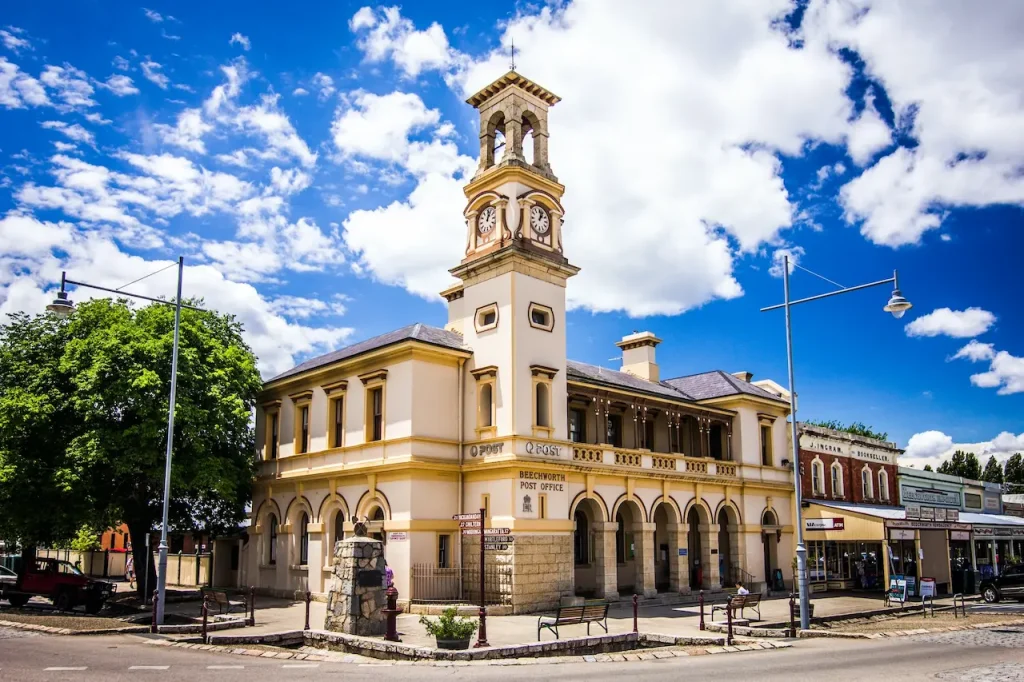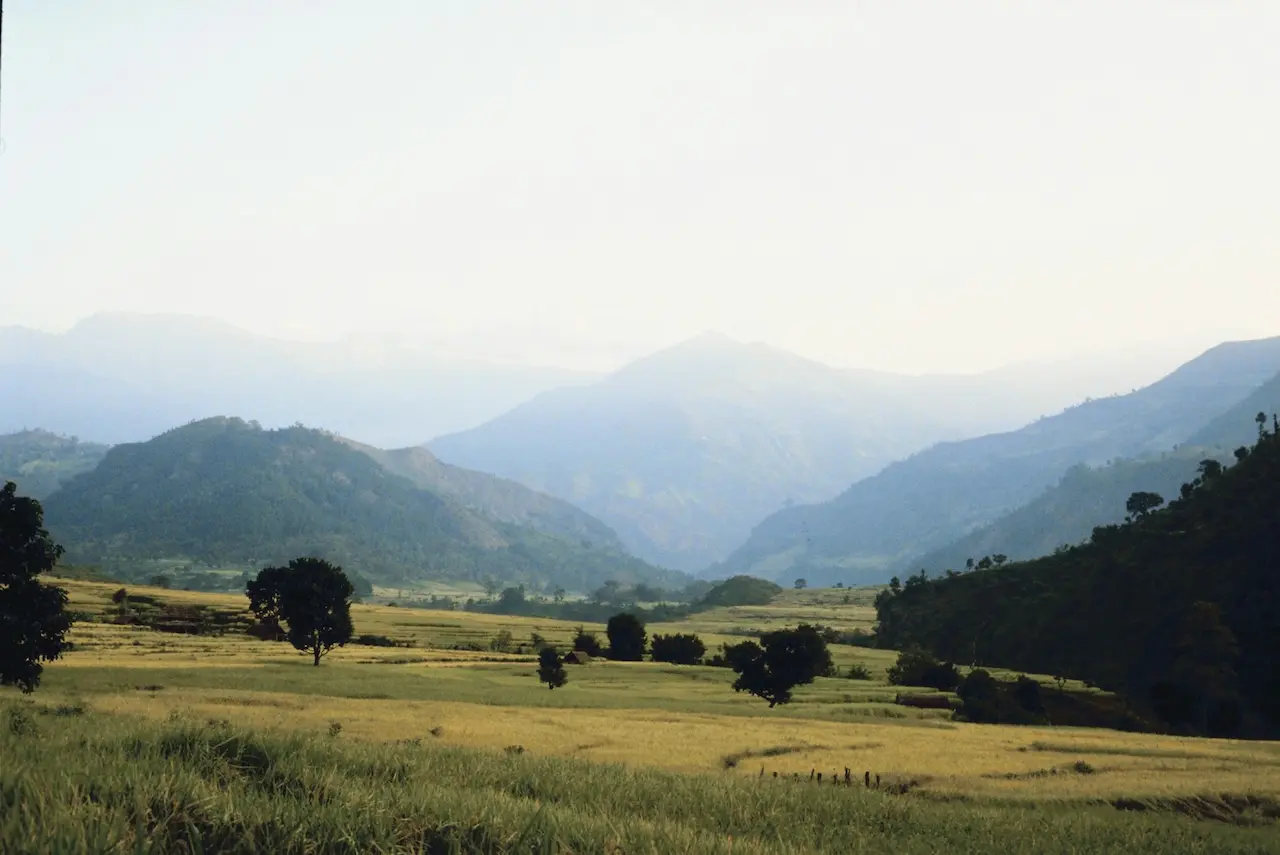Beechworth History Trail Information
Nestled amidst rolling hills and granite outcrops in northeastern Victoria, Australia, the captivating historic town of Beechworth beckons visitors to step back in time and immerse themselves in its rich Colonial and Gold Rush era history.
Take a journey into the past along the Beechworth History Trail, a treasure trove of impeccably preserved heritage streetscapes, sites, and storied landmarks.
From the bustling tents of prospectors during the 1850s gold fever to today’s lovingly restored honey-hued stone homesteads and grandiose civic buildings, Beechworth provides an unparalleled window into 19th-century Australian frontier life. This guide uncovers the main historic gems along the trail.
Table of Contents
ToggleEarly History
The Beechworth area has a documented Aboriginal history stretching back over 40,000 years. The Pallanganmiddang-speaking peoples inhabited the Ovens Valley. In the mid-1800s, prospectors discovered gold in the region, leading to a major gold rush. Hordes of miners flocked to the area seeking their fortune.
Founding of Beechworth
The Beechworth township was officially established in 1853 and soon grew to over 30,000 inhabitants. It emerged as a thriving commercial and administrative centre, becoming known as the “hub of the colony”. Beechworth was designated as a municipality in 1863 and served as a key government centre.
Architecture along the Trail
Many buildings in Beechworth’s historic centre still retain their original 1800s architecture and character. Signature architectural styles include:
Beechworth History Trail & Georgian Architecture
Georgian-style buildings reflect an elegant symmetry with their rectangular facades, multi-pane sash windows, and panelled doors. Red brick or local granite are common materials, giving a sturdy yet refined look.
Example buildings include the stately 1858 Courthouse and the 1876 Burke Museum. The Georgian style was popular for important civic structures.

Victorian Italianate
Italianate architecture adds more decorative embellishments like stucco or plaster walls, elaborate cast iron lacework trimmings on verandahs and balconies, classical columns, and detailed mouldings over windows and doors.
Building colours are more varied. The 1886 Town Hall and 1856 Tanswells Commercial Hotel display these ornate Italianate elements.
Edwardian Styles
Later Federation Edwardian buildings in the early 20th century incorporated features like timber fretwork gables, turrets with pointed conical roofs, bay windows with multi-paned leadlight windows, and extensive decorative wood trim.
The Beechworth Post Office (1903) and the Bank of Victoria (1915) demonstrate these Edwardian traits.
Beechworth History Trail & Quirky Mixes
Some Beechworth buildings uniquely blend aspects of different eras and styles. The 1878 Burke Museum combines a Georgian brick facade with Victorian Italianate iron lace balconies and lamp fittings.
The Pepper Tree House mixes Georgian symmetry with an Italianate tower and Edwardian fretwork gables. These eclectic combinations add to the diversity and charm of Beechworth’s streetscapes.
As you explore Beechworth, notice how technological innovations in materials like iron, glass, and cement allowed more elaborate ornamentation to emerge over time alongside traditional local granite and brick. Yet a subtle harmony and human scale remains evident in the historic streetscapes.
Beechworth History Trail Key Historic Buildings
Some of the major historic buildings and sites along the trail include:
Beechworth Historic Courthouse
The magnificent colonnaded Beechworth Courthouse is considered one of Australia’s finest surviving examples of Classical Revival architecture.
Four towering ionic pillars make a striking statement greeting visitors to the 1858 granite building. Upstairs housed the judge’s chambers while courtrooms occupied the ground floor interior, including the aptly named “Black Hole” holding cell.
Telegraph Station
Built from local granite in 1856-57, the Telegraph Station provided early Morse code communication links for the growing town. Telegraph operators manually transmitted and received telegraph messages until 1874, when the building became the town’s first post office.
The heritage building features rusticated granite blocks, iron-railed verandahs, a central louvred attic tower, and now contains historical exhibits.
Town Hall
Beechworth’s elaborate 1886 Town Hall, designed by prominent Melbourne architect George Fordham, exemplifies the Victorian Italianate style. The civic building features a symmetrical facade, stuccoed walls, arched colonnades, decorative cast iron balustrades, a central clocktower, and ornate parapet mouldings.
The exterior tympanum frieze depicts allegorical figures representing Commerce, Agriculture, Mining, and Progress. Inside are fine-pressed metal ceilings.
Burke Museum
Originally built as Beechworth’s Telegraph Station in 1858, this building later served as a post and telegraph office from 1874-1876.
Named the Burke Museum in 1886 in honour of explorer Robert O’Hara Burke, the museum displays historic photographs, artifacts, costumes, and memorabilia associated with the explorer and Beechworth’s colonial era. Of architectural note are the iron-railed verandahs, louvred attic towers, and eaves brackets.
Bank of Victoria
The imposing Bank of Victoria building, erected in 1867 from brick and stucco, is considered the grandest structure in Beechworth.
Designed by architects Terry & Oakden, the Italianate facade features iron lacework balconies, Corinthian columns, arched sash windows with moulded surrounds, decorative parapet, and an elaborate interior with a coffered ceiling and marble. The bank closed in 1909, and the building became the town hall in 1915.
Ovens District Hospital
Beechworth’s former Ovens District Hospital was established in 1857. Surrounded by heritage gardens, the grounds contain many original buildings, including the 1879 granite Ludwiczak Ward for ‘lunatic’ patients and the Nurses Home.
Other structures date from 1886 to the 1930s, representing a range of architectural styles from Italianate to Art Deco. The hospital closed in 1995 and is now vacant.
Daniel Sloan Store Ruins
Ruins remain from the once impressive 1858 Daniel Sloan store designed by Ovens District pioneer architect Augustus Fritsch. After being destroyed by fire in 1905, only the brick and granite facades of the imposing Victorian Italianate warehouse survive. The site retains heritage significance.
Tanswells Commercial Hotel
Originally named the Vine Hotel when built in 1856, Tanswells Commercial Hotel in Beechworth remains one of Beechworth’s most intact examples of a Victorian-era hotel. William Tanswell operated the hotel for nearly 50 years. It retains original iron-laced verandahs, stone walls, a 4-storey tower, period guest rooms and a dining room with a potbelly stove. Careful restorations allow guests to experience 19th-century country hospitality.
Oriental Claims Office
This 1856 site marks where Chinese miners registered gold claims and paid necessary fees during the gold rush era.
While often facing discrimination, Chinese miners made extensive contributions in the Beechworth goldfields. Informational plaques and an ornamental Chinese Burner pay tribute to this important cultural legacy.
Historic Personalities
Beechworth has strong connections to several key colonial figures:
Robert O’Hara Burke
This Irish police superintendent became the first European to cross Australia south to north in 1860 but perished on the return trip.
Ned Kelly
Australia’s most infamous folk hero bushranger was held in the Beechworth jail before his final showdown. His boyhood home and jail cell can be visited.
Frederick Proesche
Beechworth’s founder and first surveyor laid out the town grid in 1853. Proesche designed many of Beechworth’s schools and churches.
Thomas Beecham
Goldfields Commissioner coordinating the mining camps and diggings surrounding Beechworth in the 1850s.
Philip Skene
A pioneer and “character” who supplied stores to miners. His gravestone epitaph amusingly read, “Here lies Philip Skene – He Lived and Died”.
These key figures all left their mark on the development and evolution of the town. Informational signs and displays educate visitors about their legacies.
Historic Buildings Turned Museums
Many of Beechworth’s historic buildings have been preserved and turned into museums and cultural displays:
Beechworth Lunatic Asylum
A once-grand psychiatric hospital complex (1867-1995) is now open for historical tours showing patient dormitories and treatment areas. Eerie at night!
Beechworth Athenaeum Library and Museum
An 1858 library was given to the community by prominent philanthropist George Ware. It became a museum in 1887, displaying artifacts, art, war items, and mining implements.
Old Beechworth Prison
Built from 1858-1864, this still functioning prison holds cells used to house bushrangers and murderers in its early notorious years. Day and night ghost tours!
Stanley Athenaeum
An 1860 community hall and theatre was converted into a museum displaying gold rush performers and entertainment history.
Old Beechworth Post Office
The 1856 post and telegraph office now contains communications and postal history exhibits. Costumed staff re-enact scenes.
Powder Magazine
An 1853 gunpowder and explosives storehouse transformed into a museum of mining and geology artifacts, plus gold rush artifacts.
Old Police Barracks
1858 police quarters and stables housing exhibits on law enforcement during the gold rush era. Historic police uniforms, weapons, and cells.
These repurposed institutions provide windows into Beechworth’s past public services, civic duties, communications, policing, and incarceration systems. They showcase how gold rush prosperity shaped early development.
Geological Features
Beechworth sits within a region still bearing gold-bearing geological formations and features:
Reefs
The town is surrounded by underground veins of gold called reefs that gave rise to the surface alluvial gold deposits that attracted thousands of miners in the 1850s gold rush fevers.
Granite Outcrops
Massive granite boulders and tors protrude from the landscape around Beechworth. Granite produced the mineral-rich molten fluids that concentrated gold and minerals within quartz reefs underground.
Mine Shafts
Both open-cut mines and deep vertical shafts dug by miners searching for gold quartz reefs can be seen around Beechworth. Some are hundreds of feet deep.
Sluice Channels
Long sunken channels dug by miners to divert creek waters to sluice away gravel, sand, and soil can still be seen meandering across goldfields seeking gold flecks.
Alluvial Deposits
Remnants of the alluvial gravel, sand, and soil deposits laid down over time by rivers and creeks that contained eroded golden nuggets and dust.
Tailings Mounds
Large grim conical mounds of rocky waste material discarded by miners after extracting gold from quartz still dot areas around town.
Beechworth’s landscape remains scarred by the feverish mining activities driven by hopes of instant riches during the mid-1800s gold rush era.
Cultural Attractions and Museums
In addition to historical sites, Beechworth offers many cultural attractions and museums:
Beechworth Honey Experience
This working honey farm offers informative tours about beekeeping history, honey extraction, mead production, and beeswax candle making. Honey tastings included!
Beechworth Sweet Co.
Housed in an 1867 bakery building, this gourmet confectioner produces handmade chocolates, fudges, licorice, and old-fashioned candies using traditional methods and recipes. Delicious!
Beechworth Brewery
Enjoy craft beers like the popular Beechworth Pale Ale and Golden Ale produced on-site at this modern microbrewery founded in 2005. Cellar door tastings and sales are available.
Burkes Museum Goldfields Wildlife Park
Adjoining Burke Museum, this wildlife park displays Australian native animals like kangaroos, koalas, snakes, and over 75 bird species in a beautiful outdoor bush setting.
Beechworth Streetlife Museum
Quirky private collection of over 10,000 items showcasing 1920-50s advertising, packaging, domestic, and industrial items in a historic setting. Fabulous pop culture time capsule!
Gilchrists Model Motor Museum
Marvel at an impressive collection of intricately detailed scale model vintage cars and motorbikes, with model shops and villages also on display. A collector’s dream.
From goldfield history to honey, wildlife and beer, Beechworth’s museums cover a broad spectrum of cultural heritage. They provide opportunities to sample gourmet local flavours, too.
Historic Gardens
Several beautiful gardens around Beechworth provide a peaceful historic ambiance:
Queen Victoria Gardens
Landscaped in 1897 to honour the late Queen Victoria’s Diamond Jubilee. Features manicured lawns, a floral clock, and an ornamental pond.
Old Beechworth Gaol Gardens
Granite-walled 1863 exercise yards behind the old prison provide a shady oasis with scenic views. Escape the summer heat!
Lake Sambell Reserve
This 1857 reservoir and dam were vital for Beechworth’s early water supply. Now a scenic recreation lake set amidst mature trees and roses.
Old Asylum Gardens
Expansive 150-year-old grounds and arboretum surrounding the Lunatic Asylum ruins with botanical collections. Structures like the carriageway gatehouse remain.
These historic gardens and reserves offer shady spots to contemplate Beechworth’s past within green, serene landscapes. The large old trees, lakes, and fountains provide a picturesque setting.
Historic Walking Paths
Exploring the sites of Beechworth on foot provides interesting vantage points:
Asylum Walking Path
This trail follows along the perimeter of the Old Mayday Hills Lunatic Asylum grounds past the ward ruins, facilities, and nature areas. Interpretive signs describe its history.
Gorge Scenic Walk
This shady trail follows beautiful spring-fed Stanley Creek along the rocky gorge below Beechworth, passing historic mine tunnels and water races. A scenic outlook has panoramic views.
Beechworth Gorge Heritage Walk
This trail explores the Newtown end of the gorge, its 1863 powder magazine, and geological formations carved by water erosion that exposed gold-bearing quartz reefs underground.
Old Cemetery Trail
A walking path through Beechworth’s 1854 Pioneer Cemetery provides insights into colonial tombstones and the area’s past residents. Scenic valley views.
Beechworth’s trails allow history explorers to take in outdoor sights and natural scenery surrounding the town from an up-close vantage.
Historic Towns Nearby
Beechworth can serve as a home base to explore other historic neighbouring towns:
Yackandandah
This preserved gold rush town 15 minutes from Beechworth has antique stores, a DIG in Store mining model shop, and 1866 Chinese temples.
Rutherglen
Known for world-class local wines, this town retains historic buildings like the 1896 Rutherglen Railway Station and Billabong Distillery.
Chiltern
Home to the atmospheric Chiltern-Mount Pilot National Park with old goldfield relics scattered amidst box-ironbark forest. Historic streetscape.
Eldorado
This former gold mining village retains its antique charm and has gold panning activities in the Eldorado State Forest.
Myrtleford
Historic buildings here include a suspension bridge over the Ovens River, an old fire station, a 1901 schoolhouse, and railway heritage.
Nearby historic country villages like Eldorado and Rutherglen complement the experience of travelling back to colonial days based in Beechworth.
Beechworth History Trail & Annual Festivals and Events
Annual events that celebrate Beechworth’s culture and history include:
Harvest Celebration
This April festival marks the end of the grape harvest with winery events, food stalls, rides, and live music in scenic Lake Sambell.
Ned Kelly Weekend
Held in August, this festival involves tours, bushranger re-enactments, markets, antique appraisals, and family fun.
Beechworth Honey Festival
A September weekend filled with cooking lessons, honey tasting, beekeeper talks, and activities at Beechworth Honey’s farm.
Celtic Festival
A lively 3-day event each November featuring Celtic music, dance, food, and cultural displays. Pipe bands parade through town.
Ghost Tours
Spine-tingling lantern-lit tours offered year-round that share eerie tales of ghostly encounters around creepy historic sites like the morgue, asylum, jail, and cemetery.
These lively festivals and events let visitors experience Beechworth’s heritage in an engaging, hands-on manner and interact with local community members.
Beechworth History Trail & Planning Your Visit
Beechworth can easily be visited as a day trip from Melbourne or Wangaratta. But an overnight stay is ideal for soaking in the full historic ambience. Many motels, cottages, and charming B&Bs offer stays in restored heritage buildings. The downtown historic precinct is walkable and full of restaurants and cafes to enjoy.
Be sure to stop by the visitor centre to grab maps of key historic sites and plan out your walking tour, depending on your interests. Then get ready to be transported back in time as you trace Beechworth’s fortunes from the gold rush era to today!


